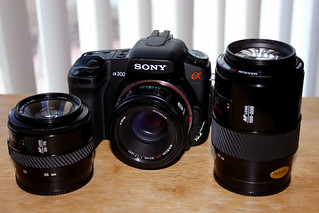Difference between revisions of "Minolta AF mount lenses"
m (→Konica Minolta) |
|||
| Line 90: | Line 90: | ||
===Konica Minolta=== | ===Konica Minolta=== | ||
| − | In 2003 [[Minolta]] joined forces with [[Konica]]. The [[Konica Minolta]] [[DSLR]]s 7D and 5D and the first series of lenses for [[APS-C]] image frame format probably were already developed by [[Minolta]]. The last camera of that series was the [[Sony Alpha DSLR-A100]] of 2006. From then the whole system was continued as digital [[camera system]], as [[Sony α system]], i.e. its [[DSLR]] and [[SLT]] cameras. | + | In 2003 [[Minolta]] joined forces with [[Konica]]. The [[Konica Minolta]] [[DSLR]]s 7D and 5D and the first series of lenses for [[APS-C]] image frame format probably were already developed by [[Minolta]]. The last camera of that series was the [[Sony Alpha DSLR-A100]] of 2006. From then the whole system was continued as digital [[camera system]], as [[Sony α system]], i.e. its [[DSLR]] and [[SLT]] cameras. Sony's system comprises two high-end lens series, the G lenses and the [[Zeiss]] lenses. |
[[Category:Japanese autofocus lenses]] | [[Category:Japanese autofocus lenses]] | ||
[[Category:Minolta AF mount]] | [[Category:Minolta AF mount]] | ||
Revision as of 10:54, 10 March 2015

|
| All DSLRs and SLTs of the Sony α system have an autofocus lens bayonet that is downward compatible to all lenses of Minolta's 35mm AF System. On a DSLR with APS-C size sensor like the Sony α300 the crop factor is 1.5. image by Wayne Young (Image rights) |
Minolta AF lenses where named Maxxum AF lenses in the USA. They all were made for Minolta's autofocus SLR system for 35mm film which was launched in 1985 with the Minolta 7000 which was the first autofocus system camera for the mass market and gave Minolta an advantage in the camera market for several years.
Contents
Minolta AF lenses in 1985
|
|
Minolta AF lenses in 2001
G lenses are high-end lenses of Minolta's optics palette.
(D) means usability for Minolta's ADI type TTL flash photography.
Apo means "almost apochromatic color correction",
i.e. should be better than the common achromatic correction.
wide angle lenses
normal lenses
portrait lenses
telephoto lenses
|
zoom lenses
converters
|
Konica Minolta
In 2003 Minolta joined forces with Konica. The Konica Minolta DSLRs 7D and 5D and the first series of lenses for APS-C image frame format probably were already developed by Minolta. The last camera of that series was the Sony Alpha DSLR-A100 of 2006. From then the whole system was continued as digital camera system, as Sony α system, i.e. its DSLR and SLT cameras. Sony's system comprises two high-end lens series, the G lenses and the Zeiss lenses.